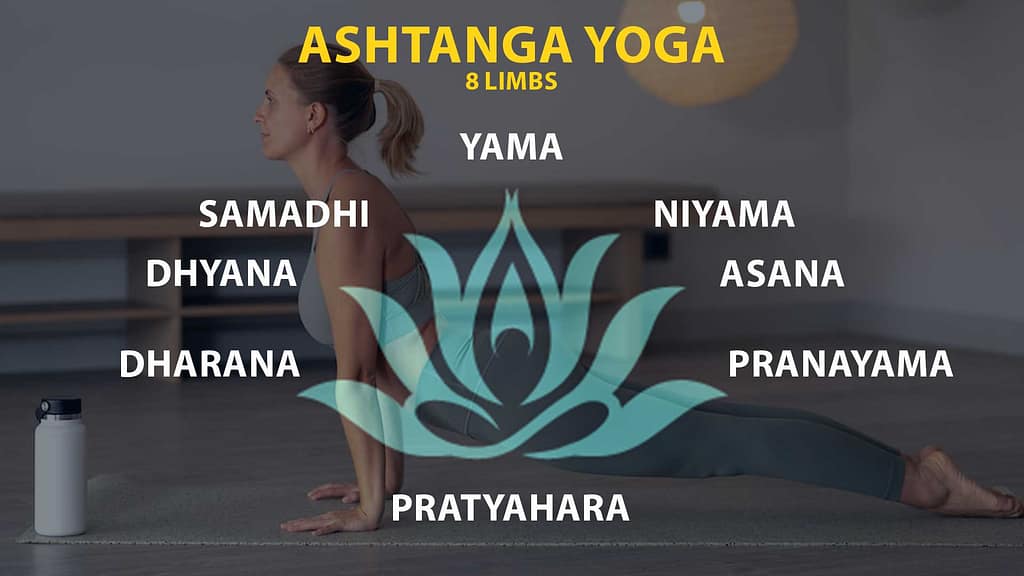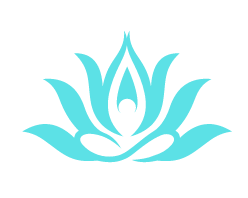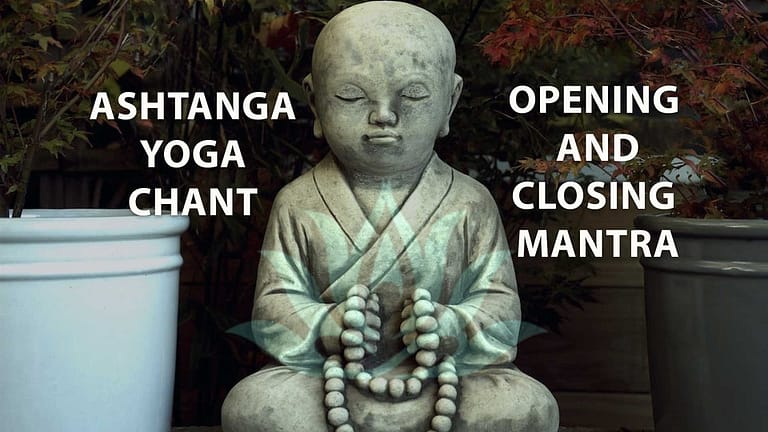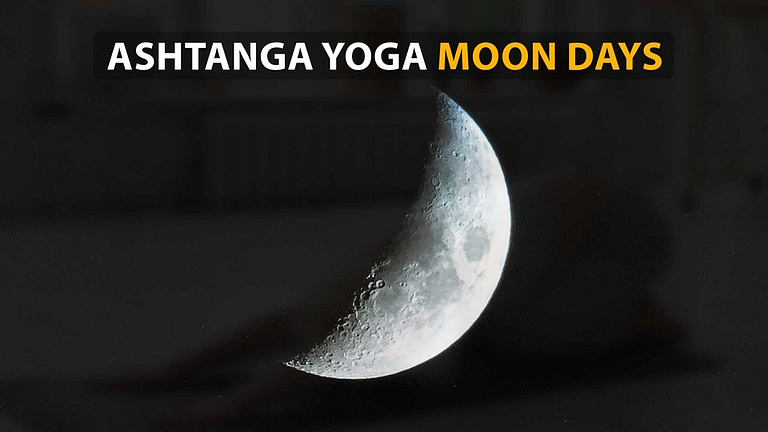What Is The Ashtanga Yoga Of Patanjali? – 8 Limbs of yoga explained

What Is The Ashtanga Yoga Of Patanjali?
Ashtanga Yoga, the famous eight limbs yoga, is one of the classical yoga styles described by Patanjali in yoga sutras. The Patanjali Yoga Philosophy is the foundation of Ashtanga yoga.
Ashtanga Yoga is a way that Patanjali says you can reach your goal with eight steps. The 8 limbs of Ashtanga yoga are Yama, Niyama, Aasan, Pranayam, Pratyahara, Dharana, Dhyaan and Samadhi.
Many people think that Asanas are the same thing as Yoga. However, Asanas are only one part of authentic Yoga.
This article will describe the most well-liked form of yoga in the Western world, “Ashtanga Yoga.
What Are The True Meaning Of Yoga?
We all know that yoga is a way to maintain discipline between mind, body and soul. The word “yoga” comes from Sanskrit, meaning “to unite.
The actual intent of yoga. The Sanskrit term “Yuj” is where the word “yoga” derives. The term “Yuj” means “to yoke” or “to combine.” In a wider context, it relates to personality harmony and is a way to create “unity.”
Read:
Yoga Pants Bulge: Is It Acceptable To Show In Public In 2023
Meaning of Ashtanga Yoga

The Ashtanga word is based upon two parts: “Ashta” and “Anga.” “Ashta” means eight, while “Anga” refers to body parts. So that’s why Ashtanga is the combination of eight limbs of yoga into one complete comprehensive system.
The eight limbs are Discipline, awareness, form, breath regulating, sense disengagement, focus, spiritual engagement, and enstasy.
Ashtanga is an extremely athletic and energetic style of yoga with a set sequence of poses. It has its roots in the smooth transformations between postures, prioritizing breath and spirit. Although being such a physical activity also develops clarity of thought and inner harmony.
Beginning Of Ashtanga Yoga
Patanjali Yoga gets its name from the sage Maharishi Patanjali, who wrote the Yoga Sutras around 2,000 years ago. These sutras are the basis of traditional yoga and give a way to practice and learn yoga in a structured way.
Ashtanga yoga is talked about in the second part of the Yoga Sutras, which is called Sadhana Pada. In this chapter, Maharishi Patanjali describes the eight limbs or parts of Ashtanga Yoga, which make up the framework for a journey through yoga that is both whole and changing.
Pattabhi Jois is considered as founder of Ashtanga technique around the 1930s or 1940s.Guru ji TKV Karishnamacharya and his student Guru ji Sri K. Pattabhi Jois evolved it in the 20th century. It was set forth by Sri K. Pattabhi Jois in the Western world in 1940.
At first, T. Krishnamacharya developed Ashtanga Yoga in the early 20th century as a customized schedule for his bright, enthusiastic student, K. Pattabhi Jois. A devoted student, Jois polished and spread this unique approach before starting to coach others.
These exciting and demanding posture routines later gave rise to numerous variations of hot yoga, flow or Vinyasa yoga, and power yoga. They bring serenity to the mind and detoxify the body.
What Is The Ashtanga Yoga Of Patanjali?
Ashtanga Yoga stresses physical strength and flexibility through coordinated movements, breathing techniques, and fixed gaze locations.

The Ashtanga approach emphasizes the value of everyday practice, in which pupils adhere to a predetermined pattern of postures.
It focuses on moving through postures in a continuous and flowing way, promoting self-discipline, mental attention, and physical strength. Under the direction of an instructor, learners try to move through predetermined sequences over time, leading to more advanced postures.
Purpose of Ashtanga yoga
1. Organized activity
Ashtanga yoga is an organized and active exercise that focuses to improve physical, mental, and spiritual health. Ashtanga Yoga is a type of yoga made famous by Sri K. Pattabhi Jois. It involves a particular order of poses (called “asanas”) and breathing methods (called “vinyasas”) that are done at the same time.
2. Coordination
Ashtanga Yoga is all about coordinating your breath with your movements, which makes for a smooth and calm exercise. The exercise is a set order of poses meant to clean and strengthen the body, make it more flexible, improve balance, and help the mind focus.
3. Discipline, self awareness, mindfulness
Ashtanga yoga has more goals than just helping your body. It aims to help people become more self-disciplined, self-aware, and mindful. Regular exercise makes a stronger connection between the mind, body, and breath, leading to a state of “moving meditation.”
Ashtanga yoga is often seen as a spiritual path because it helps people connect with their inner selves, become more apparent, and feel a sense of unity and peace.
4. Recovery in all areas of life
Ashtanga yoga’s primary goal is to support people recovery in all areas of their lives, including their bodies, minds, emotions, and spirits. People can do it with different levels of exercise, and it can be changed to fit different needs and skills.
Ashtanga yoga classes

Ashtanga yoga lessons usually come in two primary forms: the Mysore and the Led Ashtanga styles. Here’s a quick summary of each one:
Mysore style
The usual way to do Ashtanga Yoga, as educated by Sri K. Pattabhi Jois in Mysore, India, is called “Mysore style.” In a Mysore-style class, people practice the Ashtanga routine at their own pace and in their way. The course needs to be led by a teacher shouting out directions.
Instead, the students move through the series independently, with the teacher giving them individual help and making changes as needed. Mysore classes are suitable for all types of students, from beginners to experts, because each person trains based on their skills and moves forward at their own pace.
Led Ashtanga
Classes led by a teacher are more organized and taught. In these classes, a teacher guides the whole group through the Ashtanga routine by advising them on what to do and convey them how to do it. Students move in sync with each other as they follow along.
Led classes suit students who want a more organized and guided practice because the teacher cues each pose and keeps the course moving. These classes are usually ideal for people of all levels, but it helps to know the Ashtanga routine.
There are benefits to both Mysore-style and Led Ashtanga classes. Mysore-style classes give each student special attention and the chance to learn how to practice on their own, while Led Ashtanga groups are more unified and are led by a teacher.
Many practitioners find it helpful to mix the two styles, going to Mysore-style classes for personal practice and Led Ashtanga classes for more guidance and group energy.
Read:
Is Yoga A Sin, Yes Or No? According To Christianity 2023
two main types of Ashtanga yoga
1- Yoga chikitsa (Primary Series)
2- Nadi Shodana (Secondary Series)
Yoga chikitsa (Primary Series)
Yoga Chikitsa is the basic Ashtanga asana. It is famous for balancing and cleansing the body.
Nadi Shodana (Secondary Series)
The Secondary Series is built upon the foundation of the First Series but in a more advanced way. It is also known as Nadi Shodhana, which means “nerve purification.”
Patanjali’s 8 Limbs Of Ashtanga Yoga

Ashtanga means “eight limbs” in Sanskrit. These are practices that teach you how to make your life important by teaching you moral and ethical principles about yourself. The pattern is from the outside to the inside. The procedures in the eight limbs of ashtanga yoga are as follows:
1. Yama (Restrains)
This emphasizes moral standards and ethics, as well as training best practices for behavior and self-presentation.
- Ahinsa (Nonviolence)
- Satya (Truthfulness)
- Ateya (Non-Stealing)
- Brahmacharya (Continence)
- Aparigraha (Non-Covetousness)
2. Niyama (Observances)
The second limb is concerned with spiritual discipline and identity. Niyama practices include saying grace before a meal and going on solo nature walks.
- Saucha (Cleanliness)
- Samosa (Contentment)
- Tapas (Heat; Spiritual Austerities)
- Svadhyaya (Study of sacred writings and oneself)
- Isvara Pranidhana (Surrender to God).
3. Asana (Posture)

The postures used in yoga are known as asanas. By practicing asana, we improve our concentration and discipline, enabling us for the following limbs.
4. Pranayama (Breathing)

Is the broad term for breath control. It is used to link between breath, mind, and emotion in order to get control of the respiratory system. Pranayama literally means “life force extension.” This is because yogis feel it can help them live longer lives.
5. Pratyahara (Withdrawal Of The Sense)
The fifth limb is to remove from outward distractions and focus on yourself. You can watch your internal thoughts and begin to see them in a new light by separating from the senses.
6. Dharana (Concentration)
At this level, you will be free of external distractions and able to concentrate. You will learn how to slow down your thinking by focusing your attention on a single object. Learning to concentrate on a single point for long periods of time will naturally lead to meditation.
7. Dhyana (Meditation)
The continuous flow of concentration (Dharana), also known as meditation. You will be totally aware and alert without attention in this stage. It will take power and stamina to achieve this condition of calm. However, it is a necessary step in the process, and you will profit from it as you strive towards your objective.
8. Samadhi (Pure Contemplation)
This is the eighth and last limb of ashtanga. The person meditating will emerge with their focus and overcome the self entirely during Samadhi. They will achieve a state of oneness with all living things and feel the great pleasure of being at one with the world.
Benefits Of Ashtanga Yoga

Ashtanga is good for gaining strength and balance as well. It reduces body fat and increases focus and creativity. It also boosts flexibility and fitness.
It increases muscle tone and aids in coordination. Ashtanga yoga reduces back pain and is good for the cardiovascular system.
Ashtanga cleanses your inner soul and helps you stabilize your emotions and feelings. Many Ashtanga postures require you to balance on one leg or hold your whole weight on your hands.
This strengthens your core and enhances overall body strength. It also helps tone muscles and increases flexibility over time.
We all know that Ashtanga is beneficial, but if it is not performed with care and caution, there is a chance of injury. If you attempt it without any practice or awareness, it can be harmful.
You can still practice Ashtanga, starting with the fundamental series and progressing as your skills improve. Before moving on to the next series, be sure you have mastered the first.
Keep in mind that this can take years. Furthermore, when you are practicing in large groups, trainers frequently do not offer changes unless requested, increasing the danger of injury.
Read:
Is It Okay To Wear Yoga Pants In Public? – Pros And Corns In 2023
Conclusion
In short, Ashtanga yoga is an activity that can change your life. It is beneficial for your body, your mind, your emotions, and your spiritual growth.
It takes a whole-person approach to well-being and offers people a path to learn more about themselves, get more evident, and feel unity and peace. People can get the benefits of Ashtanga Yoga and start a journey of self-discovery and personal change by doing it regularly.
Some Frequently Asked Questions (FAQ’s) About Ashtanga Yoga
Q1. How Can A Beginner Start Ashtanga Yoga?
Beginners should start it with the help of an expert. Ashtanga vinyasa is suitable for them. The real power of the practice happens through the breath channel so beginners should concentrate on the breath rather than the pose.
It no longer matters what poses you do or do not do after you’ve got your attention to the breath.
Q2. What results from daily Ashtanga practice?
You gain strength and flexibility more quickly.
Q3. How Ashtanga Calms Nervous System?

In Savasana, often known as Corpse posture, when your body can absorb all of the mental and physical strength. When the mind is at ease and the body is ready for stillness, the body may easily switch into “rest and digest” mode at this time.
Q4. Is Ashtanga Reduces Lower Back Pain?
Lower back muscles are stretched and strengthened by poses in the Ashtanga Primary Series. Moreover, because you perform the same poses each time you go on the mat, you will continue to flex (and strengthen) these muscles, which might perhaps lessen low-back discomfort.
Q5. What other names does Ashtanga Yoga have?
Ashtanga yoga, also known as Ashtanga Vinyasa yoga, is a kind of yoga that was created in the 20th century by Sri K. Pattabhi Jois and T. Krishnamacharya.
Q6. Who introduced Ashtanga Yoga to the world?
Ashtanga Yoga was introduced to the world by Sri K. Pattabhi Jois. He studied under his guru, T. Krishnamacharya, and dedicated his life to teaching and spreading the Ashtanga Yoga system.
Video Guide
Read Also
- Is Yoga A Hobby? – Facts Explained. Benefits And Drawbacks in 2023
- Ashtanga Opening And Closing Mantra – Reality Of Ashtanga Chant 2023
- How Yoga Can Help You Live A Happy Life?
- Is Yoga Meant To Worship Gods? – Why Yoga Is Misunderstood As Worship? In 2023
- Does Yin Yoga Burn Calories? Benefits In 2023
- Tingling Sensation Between Eyebrows During Meditation – Third Eye Sensation In 2023






